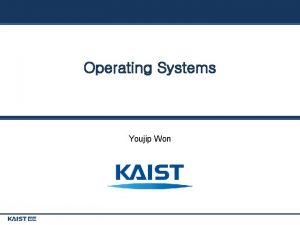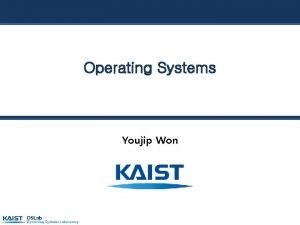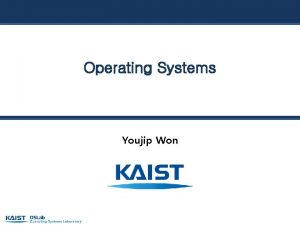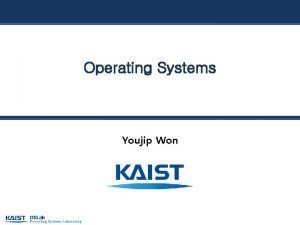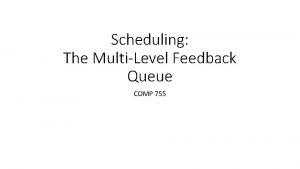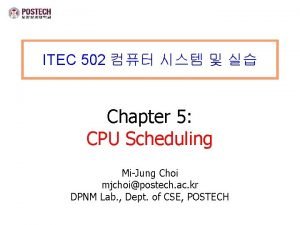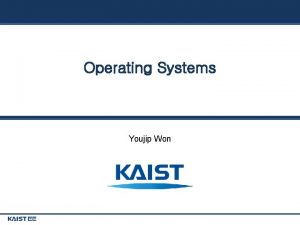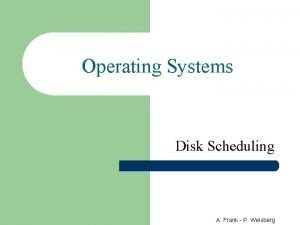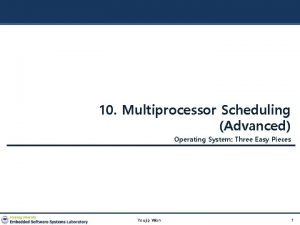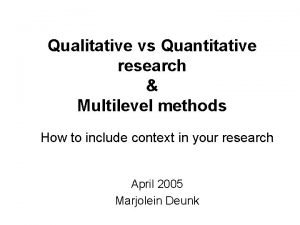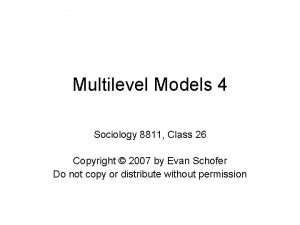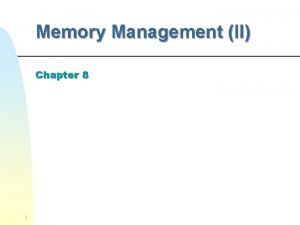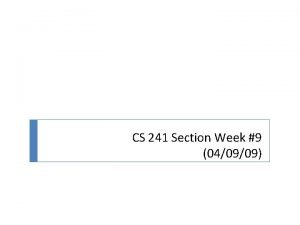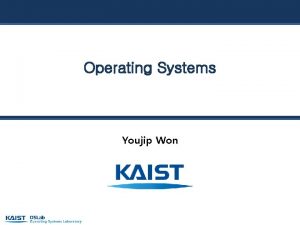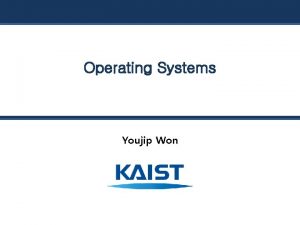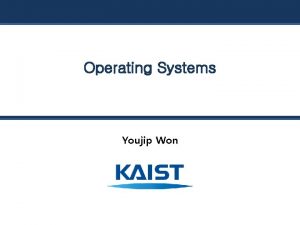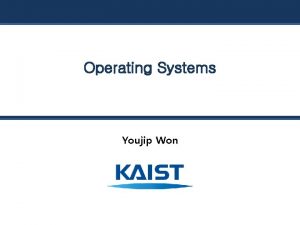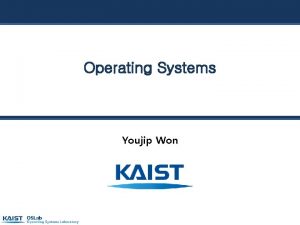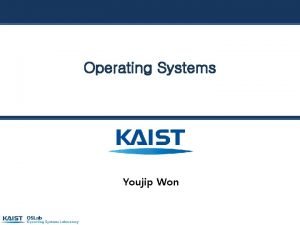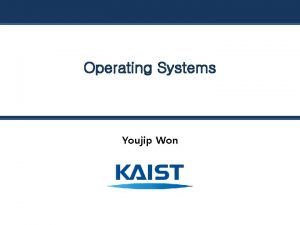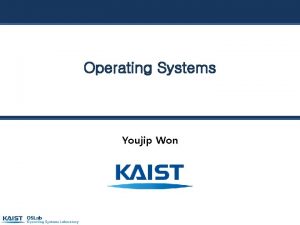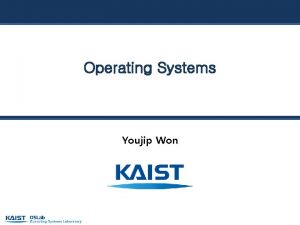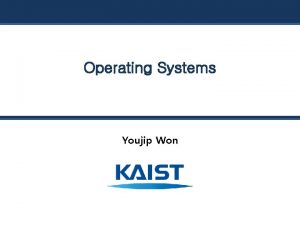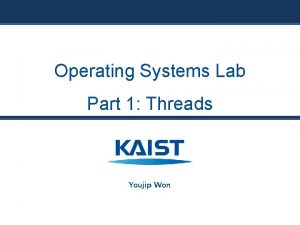Operating Systems Youjip Won 8 Scheduling The MultiLevel





![MLFQ Example [High Q 8 Priority] Q 7 A B Q 6 Q 5 MLFQ Example [High Q 8 Priority] Q 7 A B Q 6 Q 5](https://slidetodoc.com/presentation_image_h2/71f50bb075551f4165000b5aeb194a32/image-6.jpg)











- Slides: 17

Operating Systems Youjip Won

8: Scheduling: The Multi-Level Feedback Queue Youjip Won 2

Multi-Level Feedback Queue (MLFQ) A Scheduler that learns from the past to predict the future. Objective: Optimize turnaround time Run shorter jobs first Minimize response time without a priori knowledge of job length. Youjip Won 3

MLFQ: Basic Rules MLFQ has a number of distinct queues. Each queues is assigned a different priority level. A job that is ready to run is on a single queue. A job on a higher queue is chosen to run. Use round-robin scheduling among jobs in the same queue Rule 1: If Priority(A) > Priority(B), A runs (B doesn’t). Rule 2: If Priority(A) = Priority(B), A & B run in RR. Youjip Won 4

MLFQ: Basic Rules (Cont. ) MLFQ varies the priority of a job based on its observed behavior. Example: A job repeatedly relinquishes the CPU while waiting IOs Keep its priority high A job uses the CPU intensively for long periods of time Reduce its priority. Youjip Won 5
![MLFQ Example High Q 8 Priority Q 7 A B Q 6 Q 5 MLFQ Example [High Q 8 Priority] Q 7 A B Q 6 Q 5](https://slidetodoc.com/presentation_image_h2/71f50bb075551f4165000b5aeb194a32/image-6.jpg)
MLFQ Example [High Q 8 Priority] Q 7 A B Q 6 Q 5 Q 4 C Q 3 Q 2 [Low Priority] Q 1 Youjip Won D 6

MLFQ: How to Change Priority MLFQ priority adjustment algorithm: Rule 3: When a job enters the system, it is placed at the highest priority Rule 4 a: If a job uses up an entire time slice while running, its priority is reduced (i. e. , it moves down on queue). Rule 4 b: If a job gives up the CPU before the time slice is up, it stays at the same priority level In this manner, MLFQ approximates SJF Youjip Won 7

Example 1: A Single Long-Running Job A three-queue scheduler with time slice 10 ms Q 2 Q 1 Q 0 0 50 100 150 200 Long-running Job Over Time (msec) Youjip Won 8

Example 2: Along Came a Short Job Assumption: Job A: A long-running CPU-intensive job Job B: A short-running interactive job (20 ms runtime) A has been running for some time, and then B arrives at time T=100. Along Came An Interactive Job (msec) Youjip Won 9

Example 3: What About I/O? Assumption: Job A: A long-running CPU-intensive job Job B: An interactive job that need the CPU only for 1 ms before performing an I/O Q 2 A: Q 1 B: Q 0 0 50 100 150 200 A Mixed I/O-intensive and CPU-intensive Workload (msec) The MLFQ approach keeps an interactive job at the highest priority Youjip Won 10

Problems with the Basic MLFQ Starvation If there are “too many” interactive jobs in the system. Lon-running jobs will never receive any CPU time. Game the scheduler After running 99% of a time slice, issue an I/O operation. The job gain a higher percentage of CPU time. A program may change its behavior over time. CPU bound process I/O bound process Youjip Won 11

The Priority Boost Rule 5: After some time period S, move all the jobs in the system to the topmost queue. Example: A long-running job(A) with two short-running interactive job(B, C) Q 2 Q 1 Q 0 0 50 100 150 200 0 50 Without(Left) and With(Right) Priority Boost Youjip Won 100 150 A: B: 200 C: 12

Better Accounting How to prevent gaming of our scheduler? Solution: Rule 4 (Rewrite Rules 4 a and 4 b): Once a job uses up its time allotment at a given level (regardless of how many times it has given up the CPU), its priority is reduced(i. e. , it moves down on queue). Q 2 Q 1 Q 0 0 50 100 150 200 Without(Left) and With(Right) Gaming Tolerance Youjip Won 13

Tuning MLFQ And Other Issues Lower Priority, Longer Quanta The high-priority queues Short time slices E. g. , 10 or fewer milliseconds The Low-priority queue Longer time slices E. g. , 100 milliseconds Q 2 Q 1 Q 0 0 50 100 150 200 Example) 10 ms for the highest queue, 20 ms for the middle, 40 ms for the lowest Youjip Won 14

The Solaris MLFQ implementation For the Time-Sharing scheduling class (TS) 60 Queues Slowly increasing time-slice length The highest priority: 20 msec The lowest priority: A few hundred milliseconds Priorities boosted around every 1 second or so. Youjip Won 15

Free. BSD Scheduler(4. 3) MLFQ without queue. Instead, use formula. Compute the priority of a process based upon How much CPU a process has used. Boost priority by decay. Take the advice from the user (nice). For efficiency, use queue. Youjip Won 16

MLFQ: Summary The refined set of MLFQ rules: Rule 1: If Priority(A) > Priority(B), A runs (B doesn’t). Rule 2: If Priority(A) = Priority(B), A & B run in RR. Rule 3: When a job enters the system, it is placed at the highest priority. Rule 4: Once a job uses up its time allotment at a given level (regardless of how many times it has given up the CPU), its priority is reduced(i. e. , it moves down on queue). Rule 5: After some time period S, move all the jobs in the system to the topmost queue. Beauty of MLFQ It does not require prior knowledge on the CPU usage of a process. Youjip Won 17
 Youjip
Youjip Youjipp
Youjipp Common concurrency mechanisms
Common concurrency mechanisms Youjip won
Youjip won Multilevel feedback queue scheduling
Multilevel feedback queue scheduling Multilevel queue scheduling example with gantt chart
Multilevel queue scheduling example with gantt chart Cpu scheduling gantt chart
Cpu scheduling gantt chart Multilevel bus architecture in embedded systems
Multilevel bus architecture in embedded systems Sjn scheduling
Sjn scheduling Youjip
Youjip What is disk scheduling in os
What is disk scheduling in os Advanced operating system
Advanced operating system Multilevel page table
Multilevel page table Teaching multilevel esl classes
Teaching multilevel esl classes Multilevel model equation example
Multilevel model equation example Multilevel model equation example
Multilevel model equation example Multilevel paging in os
Multilevel paging in os Multilevel page tables
Multilevel page tables
